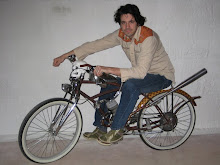Eve is my prototype cutaway
archtop. She is my largest guitar to date measuring 18" at the lower bout with a 3" body depth. I made this guitar with Ancient
Kauri wood from New Zealand. A forest of these ancient trees was unearthed by Kiwi farmers and has been carbon dated at 50,000 years old.
It is an overwhelming and humbling thought to think that the wood had been in waiting for tens of thousands of years before it came to me to be made into Eve. I feel honoured by the wood and I am very proud of this guitar. It was
lutherie romance at it's best rendering the
Kauri into what I think is my most successful guitar to date.
To build Eve was an extreme challenge and at times I had my doubts that I would be able to finish her. This guitar fought me hard but with an enormous amount of patience and
perseverance I became her master.
Kauri is a wonderful tone wood and the only gamble was to make all of Eve's parts from the same kind of wood. Usually guitars are made with a Spruce or Cedar top, hard wood sides and back, like Maple, with a Hard Maple neck or one of Mahogany. The unknown for me was whether or not all the parts would phase well with one another to produce a well balanced guitar that captured that traditional
archtop sound. It did perfectly!
Her voice is smooth and mellow with a belly rubbing bass, long sustain and a resonance that can
produce a faint
flangey effect when the strings are picked clean. Her tone is like cognac by the fire with the kids in bed and a quiet house after a fun days end. (Where's the puke bucket!) Seriously though she has a very pretty voice with a low break angle at the bridge that enhances the
pianissimo or soft touch playing. She can be strummed hard too maintaining great string
separation with a volume that has slightly less amplitude than Spruce. I love it!
The X bracing on the top plate is
Engleman Spruce with carbon fiber for added stiffness. The lower bout was carved thinner than the upper bout to ready the guitar for a floating
humbucker. The guitar could easily be left alone as is or one could also use a K&K pickup with a remote preamp. I think it would cool to have both a
humbucker and a K&K together with stealth controls on a pick guard.
I had weight savings as one of my themes. The heel of the neck is
largely made of Bass wood as is the glue surface for the top and back plates. I shaved the guitar sides down to 4.5mm with a tolerance of .25mm in either direction. Again, leaving the neck to waist a bit thicker than the lower bout. Having more mass in the upper bout is good for fighting feed back and is known for producing better sustain.
In my previous guitars I have used through
laminations of carbon fiber cloth in my necks. The carbon fiber stiffens the neck and helps it combat the effects of humidity changes and also gives lots more strength where the wood fibers are at their shortest in the 15 degree transition to the peg head. Eve's neck was done differently. I routed in two 1/4" wide by 3/16" deep troughs that followed the taper of the neck. I filled these areas with carbon fiber and Spruce struts. The struts run right into the
peghead to add strength in the short grain area and keep the neck nice and true with little fear of twisting. A two way adjustable truss rod is also employed.
The scale length is 25" with a 12" radius. The action is text book with 5/64" clearance at the 12
th fret. The nut is 1 13/16
th. The extra width is great for players who switch from classical to
archtop. Keeping with that idea I used 10 to 50 bronze strings - nice and light - so easy to play. Note bending is made easier too without feeling crowded.
Eve is a Jazz machine.


































